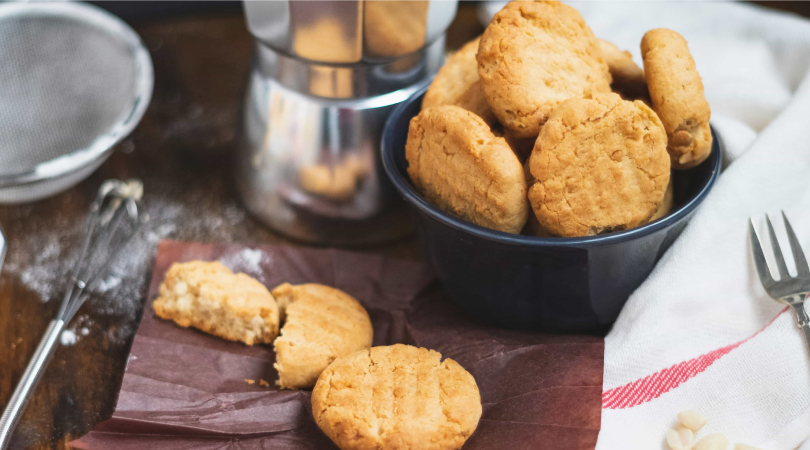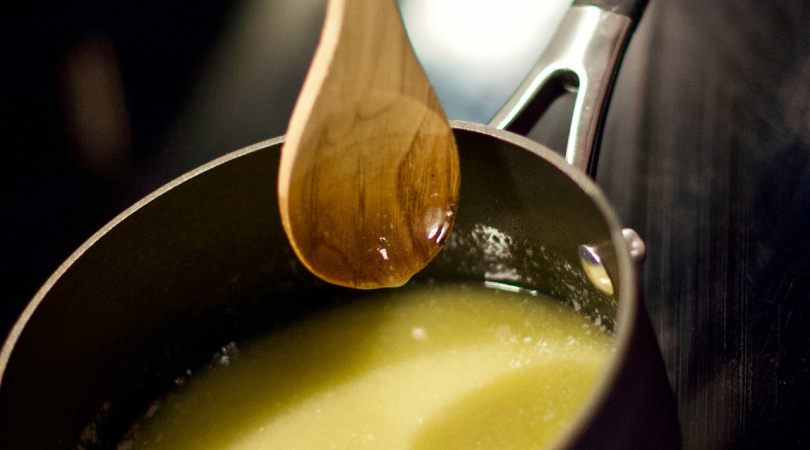What is one of the best things about the cannabis world? That there’s always a new, fun way to use it. Edibles are a game-changer, whether you’re a seasoned cannabis enthusiast or just starting out. And what is at the center of a great edible? Cannabutter!
This infused butter is the key to making potent, delicious cannabis treats that actually get you high. Keep reading to get the perfect cannabutter recipe, ideas of dishes to use it on, how to store it, and more.

What is Cannabutter?
Cannabutter is simply butter that has been infused with cannabis to activate its psychoactive compounds. This way you can add THC (or THCa, which converts to THC) to your favorite savory and sweet recipes, from brownies to pasta sauces. But before you go sprinkling raw cannabis into your food, there’s something important you need to know: activation.
How to Activate Your THCa (Decarboxylation)
THCa is just non-activated THC. It is converted into THC through heat—a process called decarboxylation. To decarboxylate, simply bake your ground cannabis at 220-240°F (105-115°C) for 30-45 minutes before infusing it into butter.
Methods for Infusing Cannabis into Butter
There are a few ways to make cannabutter, but the goal is always the same: slow, low heat for maximum infusion. Here are the most common methods:
- Stovetop: Simmering butter and cannabis on low heat for a few hours.
- Slow Cooker: A foolproof way to infuse over several hours.
- Double Boiler: This is a great method if you are afraid to burn it.
Cannabutter Recipe: How to Make Cannabis Butter
Want to know the secrets to perfect cannabutter? Here’s the step-by-step process:
Cannabutter Ingredients:
-
- 1 cup unsalted butter
- 7-10 grams of THCa flowers
Cannabutter Instructions:
-
- Melt the butter in a saucepan or slow cooker on low heat.
- Add the THCa flower and stir.
- Simmer on low heat (160-200°F) for 2-3 hours, stirring occasionally. Don’t let it boil.
- Strain the butter through a cheesecloth or fine strainer to remove plant material.
- Let it cool before storing it in an airtight container.

How Long Should You Infuse the Cannabis into Butter?
We recommend that you infuse it for at least 2 hours, but if you have the time and resources to keep it going for longer, you can infuse it for up to 6 hours. Just make sure it doesn’t boil or burn.
How to Know When Your Cannabutter is Done
You can safely remove your cannabutter from the stove if it has a deep green or golden color and a strong cannabis aroma. If it still smells like plain butter, it needs more time.
How to Strain the Plant Material from Cannabutter
You’ll want to remove the leaves and stems once your cannabutter is done, so you can use it in your recipes without adding unwanted textures. Use a cheesecloth, fine mesh strainer, or coffee filter to remove all the cannabis flower residues. Just remember to do this once the cannabutter has cooled down a bit—hot butter can burn!
Cannabutter Dosage Guide
Dosing edibles can be tricky. Here’s a general guide:
- Beginners: 5-10mg of THC per serving
- Intermediate users: 10-25mg per serving
- Advanced users: 25-50mg+ per serving
Don’t rush into taking a higher dose if you don’t feel the psychoactive effects at first. Remember edibles take longer than vapes or blunts, they can take up to 1-2 hours to feel the effects.
How Long Does Weed Butter Last?
If you store it correctly, cannabutter can last 2-3 weeks in the fridge or up to 6 months in the freezer. The good news is that the high-fat content helps preserve it, so you can have it available in your fridge without fearing it’ll go bad.
How to Store Cannabutter
Key Storage Factors:
-
- Airtight Containers: Using airtight containers is crucial to prevent oxidation and moisture buildup, which can degrade the cannabutter. Glass jars, especially mason jars, are excellent choices.
- Temperature Control:
- Refrigeration: Cannabutter can typically last for 2-3 weeks in the refrigerator when stored in an airtight container.
- Freezing: If you don’t plan to use it in the first week, you can freeze it and save it for the next months. Properly frozen cannabutter can last for several months (up to six months or more).
-
- Protection from Light: Light can degrade cannabinoids, so storing cannabutter in a dark place or using opaque containers is beneficial.
Storage Methods:
Refrigeration:
-
- Place the cannabutter in an airtight container.
- Store it in the refrigerator.
Freezing:
-
- Portion your cannabutter into smaller, individual servings using silicone molds or wrapping them in parchment paper so you don’t struggle to extract the amount you need.
- Place the portions in an airtight, freezer-safe container or freezer bag.
- Store in the freezer.
Cannabutter storage extra tips:
-
- When freezing, label the container with the date to keep track of its freshness.
- When thawing frozen cannabutter, do so slowly, to preserve its quality.
Additional Tips:
-
- Avoid storing cannabutter at room temperature for extended periods, as it can quickly become rancid.
- Ensure that any containers used are clean and dry.
- When possible, try to reduce the amount of water remaining in the butter after the cooking process. This will help to extend its shelf life.
Foods You Can Add Cannabutter To
The best part of cannabutter is how versatile it is! You can add it to both savory and sweet dishes, including:
- Brownies & cookies:
-
-
- Simply replace regular butter with cannabutter in your favorite recipes.
- You can mix regular butter and cannabutter if you want to balance its potency.
- Ensure the cannabutter is thoroughly mixed into the batter so it is evenly distributed and each portion or cookie gets the same amount of cannabutter.
-
- Pasta sauces:
-
-
- Melt cannabutter into your sauce while it’s simmering.
- For cream-based sauces, stir in cannabutter towards the end of cooking to avoid overheating.
- Add a pat of cannabutter to individual servings of pasta for precise dosing.
-
- Mashed potatoes:
-
-
- Replace some or all of the regular butter with cannabutter when mashing potatoes.
- Warm the cannabutter slightly before adding it to the potatoes for easier mixing.
- Add some fresh herbs to compliment the flavor.
-
- Popcorn:
-
-
- Melt cannabutter and drizzle it over freshly popped popcorn.
- For even coating, toss the popcorn in a bowl with the melted cannabutter.
- Add some parmesan cheese, or other spices to compliment the flavor.
-
- Coffee or tea:
-
-
- Add a small amount of cannabutter to your hot beverage and stir until dissolved.
- Add the cannabutter to your beverage when it has cooled down, so it doesn’t lose its potency.
-
- Cannabutter on toast:
-
- Spread cannabutter directly onto toasted bread.
- Finish with your favorite topping like avocado, jam, or honey.

Eating vs. Smoking/Vaping Cannabis
Edibles hit slower but harder than smoking or vaping. While inhaling THC will make you feel its effects almost instantly, edibles take 30-120 minutes to kick in but provide a longer, stronger high.
What If You Eat Raw Cannabis?
Raw cannabis won’t get you high because it needs heat (decarboxylation) to activate the psychoactive properties of THC.
Additional Cannabutter Tips
- Use high-fat butter (like European-style) for better THC absorption.
- Avoid overheating to prevent THC degradation.
- Experiment with ratios to find your ideal potency.
Cannabutter FAQs
What type of cannabis is best for making cannabutter?
The type of cannabis you use depends on your desired outcome. Both Indica and Sativa strains can be used. The potency of your cannabutter will depend on the potency of the cannabis you use.
How much cannabis should I use to make cannabutter?
The ratio of cannabis to butter depends on the potency you are looking for. A common guideline is to use 1 ounce of cannabis to 1 pound of butter, but this can be adjusted. Start with a smaller amount if you are new to making cannabutter.
What type of butter is best for cannabutter?
We recommend you use unsalted butter so you can add it to all types of recipes. Also, high-fat butter is a great option because THC and other cannabinoids bind to fats.
Can I make cannabutter with other fats besides butter?
Yes, you can. Coconut oil is a popular alternative, especially if you want to make a vegan version of the cannabutter. Other fats, like olive oil, can also be used, but butter and coconut oil are the most common.
What equipment do I need to make cannabutter?
-
- A baking sheet and parchment paper (for decarboxylation)
- A grinder
- A saucepan or double boiler, or slow cooker
- A fine-mesh strainer or cheesecloth
- An airtight container for storage
How can I avoid burning my cannabutter?
Use low heat and add water to the mixture to prevent scorching. A double boiler or slow cooker can also help maintain a consistent, low temperature. Also, consistent stirring is very helpful.
How can I make my cannabutter stronger?
Increase the ratio of cannabis to butter. Use high-potency cannabis. Extend the infusion time, but be careful not to overdo it.
How can I reduce the strong cannabis taste in my cannabutter?
-
- Rinse the THCa flowers before infusion.
- Use clarified butter.
- Use strong flavors in your edibles to mask the cannabis taste.
How can I accurately dose edibles made with cannabutter?
-
- This is challenging, as homemade cannabutter potency can vary.
- Start with a small amount of cannabutter in your recipes.
- If possible, calculate the approximate THC content of your cannabis and then divide it by the number of servings.
- Consume a small portion of the edible and wait at least 1-2 hours to assess the effects before consuming more.
The Bottom Line
Cannabutter is a fun and delicious way to turn your THCa flowers into powerful edibles. Master this recipe and you will be able to create all sorts of sweet or savory cannabis dishes. Ready to make your own cannabutter? Grab some premium THCa flowers from Certified Headies and get cooking!
